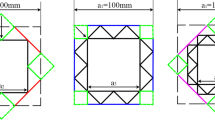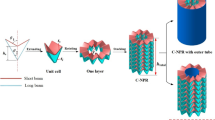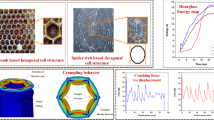Abstract
Bionic structures have been widely utilized in the crashworthiness design of thin-walled structures due to their superior energy absorption capabilities. This study constructed a bionic-shell thin-walled tube (BST) with excellent crashworthiness based on the structural bionic principle using the shell shape cross-section as the prototype. First, the theoretical model of the mean crushing force (MCF) for BST under axial compression was developed. An experiment was conducted and the reliability of the finite element model was verified. Then, the effects of structural parameters, such as the number of ribs, wall thickness, and inner tube diameter on the crashworthiness of the BST were investigated using the finite element method. Finally, to obtain the ideal configuration of structural parameters, the BST was optimized using the response surface method (RSM) with specific energy absorption (SEA) and crushing force efficiency (CFE) as the optimization objectives and peak crushing force (PCF) as the constraint condition. The results showed that the BST with six ribs exhibited the best crashworthiness under the same mass. The optimized BST-6 was found to have better energy absorption performance than the double circular tube (DCT) and the bionic-horsetail thin-walled tube (BHT). Compared with the DCT, the SEA and CFE increased by 35.15 % and 32.23 %, respectively.
Similar content being viewed by others
References
E. Cetin and C. Baykasoğlu, Energy absorption of thin-walled tubes enhanced by lattice structures, International Journal of Mechanical Sciences, 157 (2019) 471–484.
Z. Bai, C. Zhou, C. Gong, L. Zhang, W. Tan and X. Bu, Crashworthiness of bio-inspired hierarchical thin-walled square tubes, China Journal of Highway and Transport, 33 (1) (2020) 181–190.
Z. Xie, Z. Zhao and C. Li, Bending crashworthiness of thin-walled square tubes with multi-cell and double-tube cross-sections, Journal of Mechanical Science and Technology, 35 (11) (2021) 4815–4823.
A. Baroutaji, M. Sajjia and A. G. Olabia, On the crashworthiness performance of thin-walled energy absorbers: recent advances and future developments, Thin-Walled Structures, 118 (2017) 137–163.
Z. Tang, S. Liu and Z. Zhang, Crashworthiness of non-convex multi-cell thin-walled columns subjected to axial crash, Chinese Journal of Solid Mechanics, 32 (S1) (2011) 206–213.
A. A. Nia and J. H. Hamedani, Comparative analysis of energy absorption and deformations of thin walled tubes with various section geometries, Thin-Walled Structures, 48 (12) (2010) 946–954.
M. Yamashita, M. Gotoh and Y. Sawairi, Axial crush of hollow cylindrical structures with various polygonal cross-sections: numerical simulation and experiment, Journal of Materials Processing Technology, 140 (1–3) (2003) 59–64.
S. Ádány and D. Visy, Global buckling of thin-walled simply supported columns: numerical studies, Thin-Walled Structures, 54 (2012) 82–93.
Y. Xiao, H. Yin, H. Fang and G. Wen, Crashworthiness design of horsetail-bionic thin-walled structures under axial dynamic loading, International Journal of Mechanics and Materials in Design, 12 (4) (2016) 563–576.
H. N. San, G. Lu and X. Xiang, High energy absorption efficiency of thin-walled conical corrugation tubes mimicking coconut tree configuration, International Journal of Mechanical Sciences, 148 (2018) 409–421.
J. Fu, Q. Liu, K. Liufu, Y. Deng, J. Fang and Q. Li, Design of bionic-bamboo thin-walled structures for energy absorption, Thin-Walled Structures, 135 (2019) 400–413.
P. Huo, S. Xu, X. Fan, J. Li, X. Yang and H. Huang, Oblique impact resistance of a bionic thin-walled tube based on antles osteon, Explosion and Shock Waves, 40 (11) (2020) 127–138.
F. Bai, L. Zhang, Z. Bai, Z. Qin, Y. Zhang, R. Wang and W. Hu, Crashworthiness of coach’s octagonal bionic multi-cell thin-walled tubes based on beetle elytra, Journal of Vibration and Shock, 38 (21) (2019) 24–30.
X. Yang, X. Fan, S. Xu, H. Huang and P. Huo, Design and crashworthiness analysis of thin-walled tubes based on a shrimp chela structure, Explosion and Shock Waves, 40 (4) (2020) 62–72.
J. Song, S. Xu, S. Liu and M. Zou, Study on the crashworthiness of bio-inspired multi-cell tube under axial impact, International Journal of Crashworthiness, 27 (2) (2022) 390–399.
P. Yu, Z. Liu and S. Li, Design and energy absorption characteristic analysis of a new bio-bamboo thin-walled circular tube, Chinese Journal of High Pressure Physics, 35 (5) (2021) 104–114.
J. Song, S. Xu, H. Wang, X. Wu and M. Zou, Bionic design and multi-objective optimization for variable wall thickness tube inspired bamboo structures, Thin-Walled Structures, 125 (2018) 76–88.
S. Hou, Q. Li, S. Long, X. Yang and W. Li, Crashworthiness design for foam filled thin-wall structures, Materials and Design, 30 (6) (2009) 2024–2032.
W. Chen, Experimental and numerical study on bending collapse of aluminum foam-filled hat profiles, International Journal of Solids and Structures, 38 (44–45) (2001) 7919–7944.
J. M. Alexander, An approximate analysis of the collapse of thin cylindrical shells under axial loading, Quarterly Journal of Mechanics and Applied Mathematics, 13 (1) (1960) 10–15.
T. N. Tran, S. Hou, X. Han and M. Q. Chau, Crushing analysis and numerical optimization of angle element structures under axial impact loading, Composite Structures, 119 (2015) 422–435.
X. Zhang, G. Cheng and H. Zhang, Theoretical prediction and numerical simulation of multi-cell square thin-walled structures, Thin-Walled Structures, 44 (11) (2006) 1185–1191.
T. N. Tran, S. Hou, X. Han, W. Tan and N. T. Nguyen, Theoretical prediction and crashworthiness optimization of multi-cell triangular tubes, Thin-Walled Structures, 82 (2014) 183–195.
W. Chen and T. Wierzbicki, Relative merits of single-cell, multi-cell and foam-filled thin-walled structures in energy absorption, Thin-Walled Structures, 39 (4) (2001) 287–306.
S. Tabacu, Axial crushing of circular structures with rectangular multi-cell insert, Thin-Walled Structures, 95 (2015) 297–309.
Z. Zhang, S. Liu and Z. Tang, Crashworthiness investigation of kagome honeycomb sandwich cylindrical column under axial crushing loads, Thin-Walled Structures, 48 (1) (2010) 9–18.
Z. Tang, S. Liu and Z. Zhang, Analysis of energy absorption characteristics of cylindrical multi-cell columns, Thin-Walled Structures, 62 (2013) 75–84.
R. Lostado, P. V. Roldán, R. Fernandez and B. J. MarDonald, Design and optimization of an electromagnetic servo braking system combining finite element analysis and weight-based multi-objective genetic algorithms, Journal of Mechanical Science and Technology, 30 (8) (2016) 3591–3605.
Acknowledgments
This work was supported by the Fundamental Strengthening Program of the Central Military Commission Technical Filed Foundation of China (Grant No. 2021-JCJQ-JJ-1309), the Science and Technology Innovation Program of Hunan Province (Grant No. 2021RC4038) and the Natural Science Foundation of Hunan Province (Grant No. 2020JJ4026).
Author information
Authors and Affiliations
Corresponding author
Additional information
Lingyun Qin is currently a Ph.D. student in School of Mechanical Engineering, Hunan University of Science and Technology, Xiangtan, China. He received his M.S. degree in Mechanical Engineering from Hunan University of Science and Technology in 2020. His research interests include mechanical dynamics, structural design, and optimization.
Shuyi Yang is currently a Professor at the School of Mechanical Engineering, Hunan University of Science and Technology, Xiangtan, China. She received her Ph.D. degree in Mechanical Engineering from China University of Mining and Technology in 2009. Her research interests include mechanical dynamics, engineering testing, and signal processing.
Rights and permissions
About this article
Cite this article
Qin, L., Yang, S., Li, H. et al. Crashworthiness design of bionic-shell thin-walled tube under axial impact. J Mech Sci Technol 37, 3427–3436 (2023). https://doi.org/10.1007/s12206-023-0608-1
Received:
Revised:
Accepted:
Published:
Issue Date:
DOI: https://doi.org/10.1007/s12206-023-0608-1




